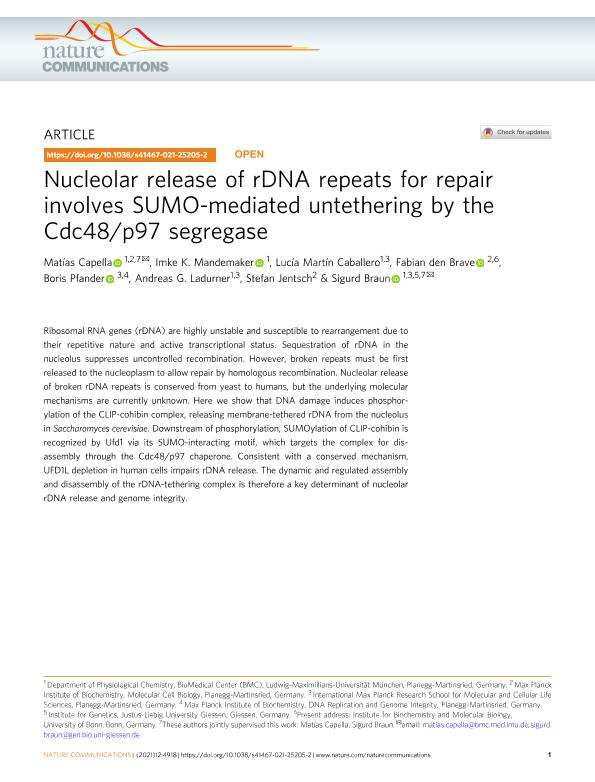Mostrar el registro sencillo del ítem
dc.contributor.author
Capella, Matias

dc.contributor.author
Mandemaker, Imke K.
dc.contributor.author
Martín Caballero, Lucía
dc.contributor.author
den Brave, Fabian
dc.contributor.author
Pfander, Boris
dc.contributor.author
Ladurner, Andreas G.
dc.contributor.author
Jentsch, Stefan
dc.contributor.author
Braun, Sigurd
dc.date.available
2023-01-09T18:33:19Z
dc.date.issued
2021-08
dc.identifier.citation
Capella, Matias; Mandemaker, Imke K.; Martín Caballero, Lucía; den Brave, Fabian; Pfander, Boris; et al.; Nucleolar release of rDNA repeats for repair involves SUMO-mediated untethering by the Cdc48/p97 segregase; Nature Publishing Group; Nature Communications; 12; 1; 8-2021; 1-16
dc.identifier.issn
2041-1723
dc.identifier.uri
http://hdl.handle.net/11336/183992
dc.description.abstract
Ribosomal RNA genes (rDNA) are highly unstable and susceptible to rearrangement due to their repetitive nature and active transcriptional status. Sequestration of rDNA in the nucleolus suppresses uncontrolled recombination. However, broken repeats must be first released to the nucleoplasm to allow repair by homologous recombination. Nucleolar release of broken rDNA repeats is conserved from yeast to humans, but the underlying molecular mechanisms are currently unknown. Here we show that DNA damage induces phosphorylation of the CLIP-cohibin complex, releasing membrane-tethered rDNA from the nucleolus in Saccharomyces cerevisiae. Downstream of phosphorylation, SUMOylation of CLIP-cohibin is recognized by Ufd1 via its SUMO-interacting motif, which targets the complex for disassembly through the Cdc48/p97 chaperone. Consistent with a conserved mechanism, UFD1L depletion in human cells impairs rDNA release. The dynamic and regulated assembly and disassembly of the rDNA-tethering complex is therefore a key determinant of nucleolar rDNA release and genome integrity.
dc.format
application/pdf
dc.language.iso
eng
dc.publisher
Nature Publishing Group

dc.rights
info:eu-repo/semantics/openAccess
dc.rights.uri
https://creativecommons.org/licenses/by-nc-sa/2.5/ar/
dc.subject
Ribosomal DNA
dc.subject
Genome stability
dc.subject
DNA damage
dc.subject
Saccharomyces cerevisiae
dc.subject.classification
Bioquímica y Biología Molecular

dc.subject.classification
Ciencias Biológicas

dc.subject.classification
CIENCIAS NATURALES Y EXACTAS

dc.title
Nucleolar release of rDNA repeats for repair involves SUMO-mediated untethering by the Cdc48/p97 segregase
dc.type
info:eu-repo/semantics/article
dc.type
info:ar-repo/semantics/artículo
dc.type
info:eu-repo/semantics/publishedVersion
dc.date.updated
2022-09-21T16:17:52Z
dc.journal.volume
12
dc.journal.number
1
dc.journal.pagination
1-16
dc.journal.pais
Reino Unido

dc.description.fil
Fil: Capella, Matias. Max Planck Institute Of Biochemistry.; Alemania. Ludwig Maximilians Universitat; Alemania. Consejo Nacional de Investigaciones Científicas y Técnicas; Argentina
dc.description.fil
Fil: Mandemaker, Imke K.. Ludwig Maximilians Universitat; Alemania
dc.description.fil
Fil: Martín Caballero, Lucía. Ludwig Maximilians Universitat; Alemania. International Max Planck Research School For Molecular Life Sciences: From Biological Structures To Neural Circuits; Alemania
dc.description.fil
Fil: den Brave, Fabian. Max-planck-institut Für Biochemie; Alemania. Universitat Bonn; Alemania
dc.description.fil
Fil: Pfander, Boris. International Max Planck Research School For Molecular Life Sciences: From Biological Structures To Neural Circuits; Alemania. Max-planck-institut Für Biochemie; Alemania
dc.description.fil
Fil: Ladurner, Andreas G.. International Max Planck Research School For Molecular Life Sciences: From Biological Structures To Neural Circuits; Alemania. Ludwig Maximilians Universitat; Alemania
dc.description.fil
Fil: Jentsch, Stefan. Max-planck-institut Für Biochemie; Alemania
dc.description.fil
Fil: Braun, Sigurd. Ludwig Maximilians Universitat; Alemania. Justus-liebig-universität Giessen; Alemania. International Max Planck Research School For Molecular Life Sciences: From Biological Structures To Neural Circuits; Alemania
dc.journal.title
Nature Communications

dc.relation.alternativeid
info:eu-repo/semantics/altIdentifier/url/https://www.nature.com/articles/s41467-021-25205-2
dc.relation.alternativeid
info:eu-repo/semantics/altIdentifier/doi/http://dx.doi.org/10.1038/s41467-021-25205-2
Archivos asociados
